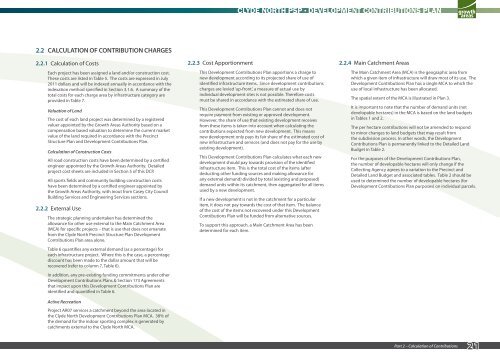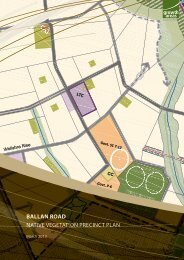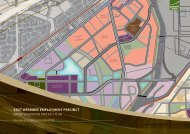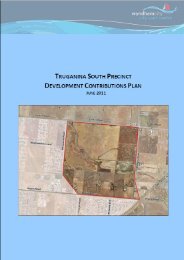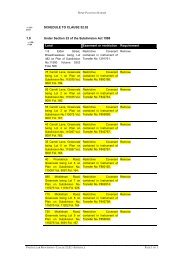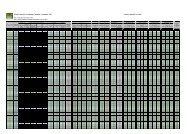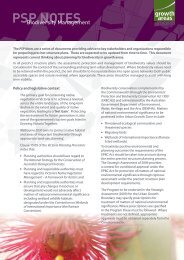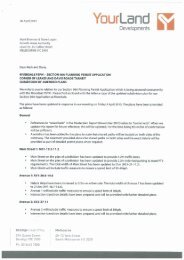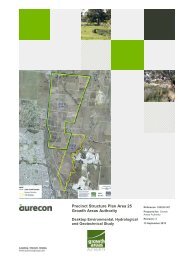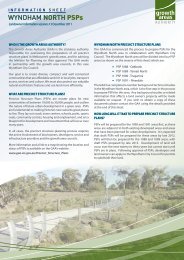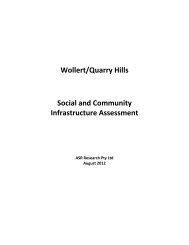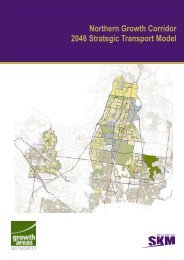Development Contributions Plan - Growth Areas Authority
Development Contributions Plan - Growth Areas Authority
Development Contributions Plan - Growth Areas Authority
Create successful ePaper yourself
Turn your PDF publications into a flip-book with our unique Google optimized e-Paper software.
2.2 CALCULATION OF CONTRIBUTION CHARGES<br />
2.2.1 Calculation of Costs<br />
Each project has been assigned a land and/or construction cost.<br />
These costs are listed in Table 5. The costs are expressed in July<br />
2011 dollars and will be indexed annually in accordance with the<br />
indexation method specified in Section 3.1.6. A summary of the<br />
total costs for each charge area by infrastructure category are<br />
provided in Table 7.<br />
Valuation of Land<br />
The cost of each land project was determined by a registered<br />
valuer appointed by the <strong>Growth</strong> <strong>Areas</strong> <strong>Authority</strong> based on a<br />
compensation based valuation to determine the current market<br />
value of the land required in accordance with the Precinct<br />
Structure <strong>Plan</strong> and <strong>Development</strong> <strong>Contributions</strong> <strong>Plan</strong>.<br />
Calculation of Construction Costs<br />
All road construction costs have been determined by a certified<br />
engineer appointed by the <strong>Growth</strong> <strong>Areas</strong> <strong>Authority</strong>. Detailed<br />
project cost sheets are included in Section 5 of this DCP.<br />
All sports fields and community building construction costs<br />
have been determined by a certified engineer appointed by<br />
the <strong>Growth</strong> <strong>Areas</strong> <strong>Authority</strong>, with inout from Casey City Council<br />
Building Services and Engineering Services sections.<br />
2.2.2 External Use<br />
The strategic planning undertaken has determined the<br />
allowance for other use external to the Main Catchment Area<br />
(MCA) for specific projects – that is use that does not emanate<br />
from the Clyde North Precinct Structure <strong>Plan</strong> <strong>Development</strong><br />
<strong>Contributions</strong> <strong>Plan</strong> area alone.<br />
Table 6 quantifies any external demand (as a percentage) for<br />
each infrastructure project. Where this is the case, a percentage<br />
discount has been made to the dollar amount that will be<br />
recovered (refer to column 7, Table 6).<br />
In addition, any pre-existing funding commitments under other<br />
<strong>Development</strong> <strong>Contributions</strong> <strong>Plan</strong>s & Section 173 Agreements<br />
that impact upon this <strong>Development</strong> <strong>Contributions</strong> <strong>Plan</strong> are<br />
identified and quantified in Table 6.<br />
Active Recreation<br />
Project AR07 services a catchment beyond the area located in<br />
the Clyde North <strong>Development</strong> <strong>Contributions</strong> <strong>Plan</strong> MCA. 38% of<br />
the demand for the indoor sporting complex is generated by<br />
catchments external to the Clyde North MCA.<br />
2.2.3 Cost Apportionment<br />
CLYDE NORTH PSP DEVELOPMENT CONTRIBUTIONS PLAN<br />
This <strong>Development</strong> <strong>Contributions</strong> <strong>Plan</strong> apportions a charge to<br />
new development according to its projected share of use of<br />
identified infrastructure items. Since development contributions<br />
charges are levied ‘up-front’, a measure of actual use by<br />
individual development sites is not possible. Therefore costs<br />
must be shared in accordance with the estimated share of use.<br />
This <strong>Development</strong> <strong>Contributions</strong> <strong>Plan</strong> cannot and does not<br />
require payment from existing or approved development.<br />
However, the share of use that existing development receives<br />
from these items is taken into account when calculating the<br />
contributions expected from new development. This means<br />
new development only pays its fair share of the estimated cost of<br />
new infrastructure and services (and does not pay for the use by<br />
existing development).<br />
This <strong>Development</strong> <strong>Contributions</strong> <strong>Plan</strong> calculates what each new<br />
development should pay towards provision of the identified<br />
infrastructure item. This is the total cost of the items (after<br />
deducting other funding sources and making allowance for<br />
any external demand) divided by total (existing and proposed)<br />
demand units within its catchment, then aggregated for all items<br />
used by a new development.<br />
If a new development is not in the catchment for a particular<br />
item, it does not pay towards the cost of that item. The balance<br />
of the cost of the items not recovered under this <strong>Development</strong><br />
<strong>Contributions</strong> <strong>Plan</strong> will be funded from alternative sources.<br />
To support this approach, a Main Catchment Area has been<br />
determined for each item.<br />
2.2.4 Main Catchment <strong>Areas</strong><br />
The Main Catchment Area (MCA) is the geographic area from<br />
which a given item of infrastructure will draw most of its use. The<br />
<strong>Development</strong> <strong>Contributions</strong> <strong>Plan</strong> has a single MCA to which the<br />
use of local infrastructure has been allocated.<br />
The spatial extent of the MCA is illustrated in <strong>Plan</strong> 3.<br />
It is important to note that the number of demand units (net<br />
developable hectares) in the MCA is based on the land budgets<br />
in Tables 1 and 2.<br />
The per hectare contributions will not be amended to respond<br />
to minor changes to land budgets that may result from<br />
the subdivision process. In other words, the <strong>Development</strong><br />
<strong>Contributions</strong> <strong>Plan</strong> is permanently linked to the Detailed Land<br />
Budget in Table 2.<br />
For the purposes of the <strong>Development</strong> <strong>Contributions</strong> <strong>Plan</strong>,<br />
the number of developable hectares will only change if the<br />
Collecting Agency agrees to a variation to the Precinct and<br />
Detailed Land Budget and associated tables. Table 2 should be<br />
used to determined the number of developable hectares (for<br />
<strong>Development</strong> <strong>Contributions</strong> <strong>Plan</strong> purposes) on individual parcels.<br />
21<br />
Part 2 – Calculation of <strong>Contributions</strong> 21


